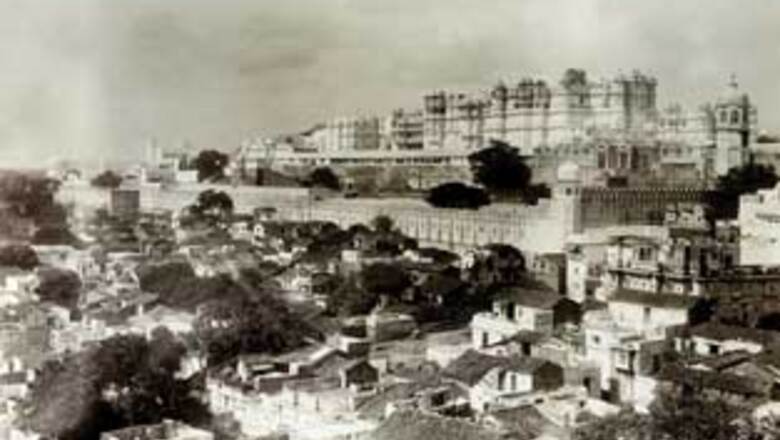
views
Catalogue and collate the photography archives stored within the inner recesses and storerooms of Udaipur's vast City Palace complex. This simple brief, covering around 3,000 photographs, has grown into a mammoth task for Consultant-Curator at the City Palace Museum, Pramod Kumar K G. The archive has emerged as one of the richest finds of 19th and early 20th century photography in India: 15,000 photographs and still counting. He estimates that the end count will be around 18,000, assuming one were to stop counting in 1947, when Mewar merged into the Indian union.
The collection, now a part of the Pictorial Archives of the Maharanas of Mewar, Udaipur, has a rich collection of photographic material covering the various formats, mediums, sizes and presentation options popular in the early years of photography in India.
Photography arrived in Calcutta in 1840. This archive shows that the medium seems to have reached the western ends of the country rather quickly: The earliest photographs suggest an early 1850 attribution.
These photographs form the nucleus of the first photography exhibition at the newly restored state-of-the-art - controlled lighting, acid-free archival mounts, museum grade frames - Bhagwat Prakash Gallery in the Zenana Mahal at the City Palace.
Titled Long Exposure: The Camera at Udaipur, 1850 – 1950, it is a concise view of how the Maharanas of Mewar patronised the new medium from the reign of Shambu Singh. Photographs from the time of his predecessor exist, but there are none of the ruler himself. In fact, it was only under his successor, Sajjan Singh, who modernised Mewar, that photography came into its own. An indefatigable sitter, he posed for countless images before the lens, leaving behind a rich legacy of images to remember him by.
The Mewar archives include glass-plate negatives, card photographs, photomontages, and painted photographs, and show the results of printing processes like albumen, platinum and gelatin silver. The exhibition of 129 vintage prints shows formats like the early carte-de-visite photographs and the painted photographs (or prints hand-tinted with water colours and oils) very popular in the late 19th century, a legacy of the court artists at Udaipur and painters from nearby Nathdwara.
These colourised images provide some of the most evocative and unusual visuals in the exhibition. Colour was often added to sepia prints to highlight the intricacies of the textiles and jewelry worn by the sitters. These photographs achieve a new dimension when landscape specialists like Thakker Singh added detailed imaginary landscapes. Today's professionals would call it photoshopping.
The only 19th-century images of women in the exhibition appear in the form of cartes-de-visite from the 1850s to the mid-1890s. Most of these women are very possibly dancing girls, performing musicians, or courtesans, as noted in their titles inscribed in Mewari behind each photograph. The absence of images of women from the royal family or of the court is because purdah was still prevalent with the Rajputs. The early demise of the wives of Maharana Fateh Singh, and his essentially austere and Spartan life, meant that for a period of over 45 years, there were very few royals in the zenana, and consequently, not much activity that necessitated photography there.
The exhibition is also a fascinating chronicle of the evolution of studio photography in the region. Many of the early images clearly indicate that the photographs were taken in makeshift studios, possibly within the palace complexes. From the 1860s, we begin to see examples of photographs taken by prominent studios based at Calcutta and Simla, the summer and winter capitals of the Raj, including Johnston and Hoffmann, Bourne & Shepherd, Herzog & Higgins, I. Cowell, A.R. Datt, and Devare. Local photographers, and studios run by Mohan Lal the court photographer and Shrimal studios also covered court events.
The collection is thoughtfully curated and well researched; it reveals not only the personas of the Maharanas in individual portraits, but also captures them in their courts, the formal hierarchy of court proceedings reflected in the order of officials seated alongside. By the mid-twentieth century, Bhupal Singh is often seen not only amongst his courtiers but also with commoners, the camera reflecting the change in status of the ruler as his interaction with his subjects increased, keeping in sync with changing times and shedding formality.
PAGE_BREAK
Among the significant images is a rare photograph of Bhupal Singh with his father Fateh Singh, in the presence of Prince Albert Victor and the Duke of Connaught, visitors to the court. This is one of the only two photographs that show the father and son together.
Then there is a shot of the ruling princes of India posing in front of the City Palace at Alwar, by the Mhow-based Herzog & Higgins Studio. Careful examination reveals that these rulers never actually posed as a group; the image is a clever photomontage from individual portraits of the rulers. It was probably a publicity device to visually depict the studio's distinguished patrons.
As Pramod Kumar says, "It's a photography show, not just a show of history. It's a show that shows the progress from feudalism to democracy, the evolution of photo journalism, the evolution of aesthetism and tells many such significantly interesting stories." And it's also a step in a bigger master plan.
Arvind Singh, current head of the Mewar dynasty, tells us that the creation of a modern gallery within the antiquated precincts of the palace was a significant addition to its history. For him, the complex is a "dynamic living heritage, constantly evolving. We cannot look at it as a palace built 500 years ago, full stop. We see it as a palace built 500 years ago and continuing." His plans for the future include refurbishment and overhauling of the museum in totality to match the expectations of well-travelled visitors. He says that nowhere else will there be a museum with such variety. On the cards are galleries for silver, paintings and musical instruments.
The work on the museum dovetails with a larger conservation plan that aims to meet contemporary requirements while preserving architectural richness, he says.
His motivations are clear. "The Taj Mahal, Chittor, they're very beautiful but there is a cut off point for them. You can still relate to the stories of the Taj but there is no involvement after that. I'm not saying that such properties shouldn't be promoted, conserved, viewed or spoken about, but it's imperative to understand the difference between a living heritage and a monument. The people of Udaipur, and India, need to be reminded of their own heritage that is alive and vibrant and yet ever-growing. It is fashionable to talk about the V & A, the Guggenheim, Angkor Vat and underplay our own but for how long are [we] going to continue indulging in this colonial hangover?"
Speaking about the Maharana Mewar Charitable Foundation (MMCF) that manages the museum, he says, "We are looking at heritage as an enterprise and no heritage can be preserved unless there is a slight commercial bent to it. No one has bottomless deep pockets."
MMCF works largely in the field of conservation and perpetuation. It is the recipients of a Getty Grant, which means that it must match the funds it receives. The first part of the grant helped prepare a master plan for the City Palace complex and now finer details are being worked on. Looking at heritage as a manageable enterprise with a slight commercial bent helps manage and pays for its maintenance, upkeep and development.
Clearly, Udaipur is working hard to maintain its position as one of the hottest tourist destinations in the world. The City Palace continues to be its single largest tourist attraction, and its evolution into a modern museum complex will help fuel the city's future growth.
(Mita Kapur is a writer and literary consultant who lives and works in Jaipur)



















Comments
0 comment